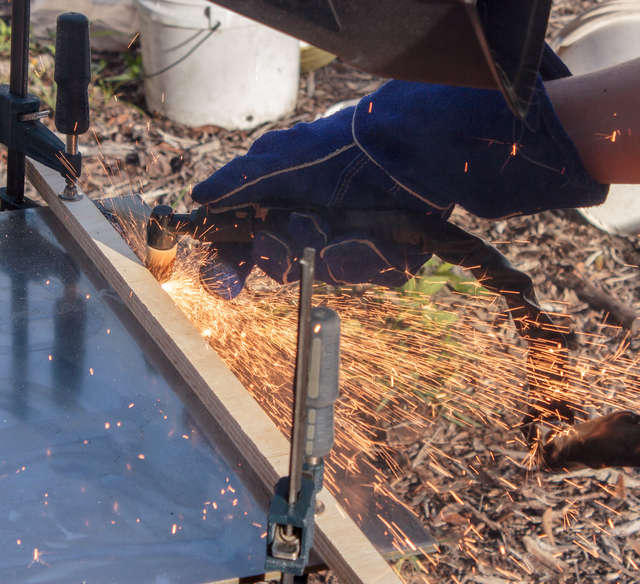Nah, this isn’t about 55 gallon drums as my wife nearly thought it was. It’s about drums used in modern metal music.
Recently I wrote a post on gearslutz replying to someone that really likes room mics, but is also editing some metal drums. Since I do this quite a lot, I wrote a bit of a post explaining some tips. I’ve copied the post here as well. Click through for the whole post.
Ok, so I edit a lot of metal drums, and I also really love room mics.
The main issue is that when you cut up your kick/snare so it sounds metronomic, as most modern metal styles require, you get this gaps in your room and overheads that make the ambience and cymbals sound really weird.
There’s never really any perfectly good solution to this problem, but there are a few things you can try. Which one that you use depends on the playing, the specific genre of metal, the part of the sound, size of the room etc…
-
Comp takes, don’t edit them - I’m sure you don’t have this option now, but it’s the best option next time.
Try to record as many takes of each section as you possibly can. If I can afford it I will record 40-50 takes of a single part or until the drummer throws a tantrum. You may be surprised that often [I]a really terrible drummer will screw up and get it right[/I]. Just comp that in and you’re done.
As a sidenote, I find that when working with metal musicians they often appreciate being really pushed on parts. You have to be careful to frame it positively. Things like “I think you can do that part a lot better, I heard you nail it during warmup” make a big difference. Saying something like, “That wasn’t too hot, we need to do it again” will absolutely ruin the session.
-
Make big edits first. - Some drummers will play a consistent tempo but get shifted off early/late a bit.
- Simply cut at a ‘mistake’ and move it in to place with everything to the right of it with it still attached.
- Now listen.
- Go to the next mistake of similar severity and repeat. Do the entire track only focusing on big mistakes. Listen and see how it sounds.
- If necessary, reiterate with the next tier of mistake severity.
- Stop when the track sounds acceptable. With some drummers you can get away with only making a handful of edits to fix hundreds of poor hits!
If you get in to a myopic ‘hit-to-the-grid’ editing flow, you can often miss the fact that by shifting just a phrase over, you’ve basically corrected everything enough to be useable.
-
Do not group the Room/OH when editing - I know this sounds counter-intuitive, but this is the option I choose most often when things have really gone downhill.
Most drummers play poorly, but consistently poorly. There’s some mechanic that causes them to be always late on specific phrases, early after other specific phrases, or whatever. You may not hear it at first but I assure you that you’ll notice it after trying this.
If the edits aren’t too massive, after kick/snare editing without touching the room/OH you’ll notice that the track will sound a bit weird, but it similar phrases always sound similarly weird. In the context of the mix this is usually acceptable. Sometimes when it’s centered largely around transitional phrases (fills) it’s even an appropriate sound that gives more movement to the track.
-
Corollary to the above: Put a rather extreme high-pass on the unedited tracks as well. It really helps with the clarity of the low-end.
-
Do individual track editing with cuts or audio warping. (bend, stretch, elastic audio, whatever your DAW calls it)
Specifically, I very often will copy the hit markers from the kick track to the Room/OH and quantize the Room/OH only with the audio warping feature of the DAW. Then do normal slicing edits on your Kick and Snare.
Note: Most DAWs audio warping features sound significantly better the more you can get away with low-passing them [I]before you apply the warping[/I]. Listen to your Room/OH and see how much you can stand low-pass them (usually way more on the room), then apply that processing. Now warp them. High-end is the enemy.
-
Use audio warping (whatever your DAW calls it) on any parts with washy cymbals. Use slicing everywhere else.
-
**Abuse your DAWs ‘Fill Gaps’ functionality.**
Specifically learn to use it in short selections. A big mistake people do is using the ‘Fill Gaps’ on the whole track, which usually doesn’t sound right. Use it on small phrase-based selections of the track.
It really depends on which DAW you use how this functional can be abused, but I strongly suggest intimately learning how your DAW’s ‘Fill Gaps’ function works. It’s indispensable.
-
If the part is somewhat on time, edit the other tracks to the drums.
Often ‘tightness’ is a better goal than metronomic accuracy. Generally guitar tracks in chuggy/djenty genres are much easier to edit to drums than vice versa. In death-metal stuff it doesn’t work too well, but it’s worth mentioning.
Make sure you’re familiar with your DAW’s ability to snap to nearby beat markers.
-
Make your own Room track
This won’t help with your OH’s sounding awful still, but you can definitely use a reverb and EQ to make up your own “Post-edit room track”. Use small room presets, high-shelf down a few DB on the track, usually a big bell cut on ~1k, a bit of saturation.
Honestly, I rarely do this.
Those are my tips assuming that you don’t want to use overbearing sample replacement or just re-record the whole damn thing with a better drummer.
Good luck.
